Explore Hangzhou - China Travel, Asia
Hangzhou, the capital of Zhejiang Province in eastern China, is a city where ancient charm meets modern vibrancy. Renowned for its breathtaking natural beauty and rich cultural heritage, Hangzhou is a must-visit destination for travelers seeking an authentic Chinese experience. With its picturesque landscapes, historic landmarks, and dynamic local culture, Hangzhou offers a unique blend of history and modernity. From tranquil lakes and historic temples to busy marketplaces and modern attractions, this city is a treasure mine of experiences waiting to be discovered.
Population: Approximately 12 million in 2020.
Economy: Logistics and manufacturing hub of coastal China and the second largest e-commerce center after Guangzhou.
Landmarks: Famous for the serene West Lake, Lingyin Temple, and Tea Plantations of Longjing (Dragon Well).
China
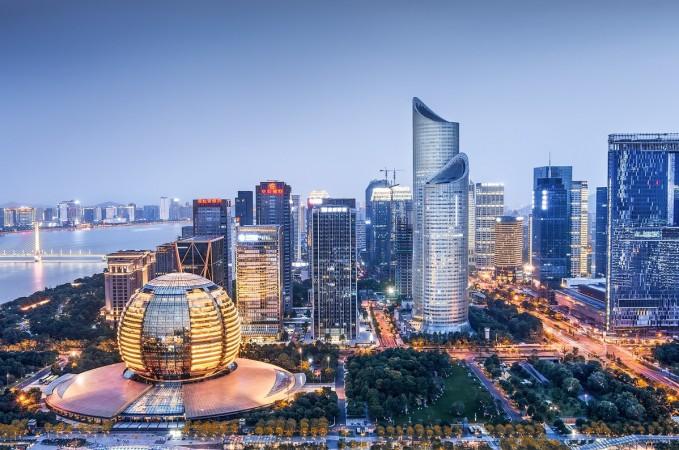
Overview of Hangzhou
History & Culture Influence
Hangzhou’s historical significance stretches back over a thousand years. It flourished during the Song Dynasty (960-1279), when it was the empire's capital and a major center for trade and culture. The city's history is deeply intertwined with its cultural landmarks, including the majestic West Lake and the revered Lingyin Temple. The influence of the Song Dynasty is evident in Hangzhou’s traditional architecture and cultural practices. This period marked a golden age for the city, where art, literature, and commerce thrived. Today, Hangzhou's antique alleyways, old pagodas, and tea plantations provide a look into the city's rich history.
Interaction with The Locals
Hangzhou, the capital of Zhejiang Province, has a population of approximately 12 million people. The city has a diversified and thriving community that combines traditional Chinese traditions with modern influences. Its residents are known for their hospitality and pride in Hangzhou's rich cultural heritage. The city’s population includes a mix of local Han Chinese and various ethnic minorities, contributing to its dynamic cultural landscape. Hangzhou's citizens enjoy a high quality of life, supported by the city's thriving economy, beautiful surroundings, and strong cultural identity. They are also known for their warm hospitality and friendly demeanor. While Mandarin is the primary language, many locals in tourist areas speak basic English.
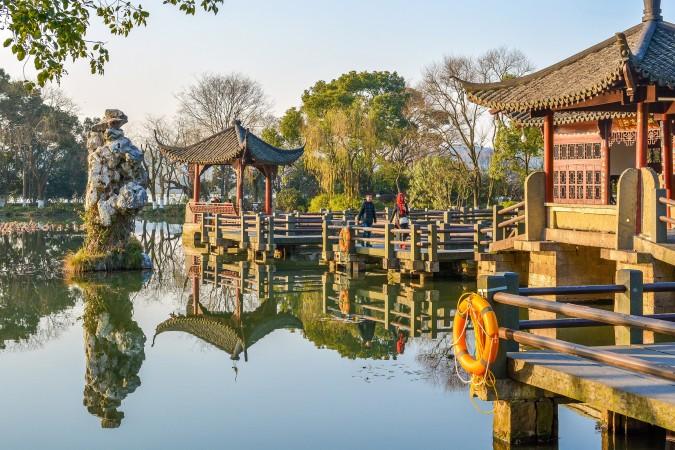
Traditional architecture in Hangzhou - © Association Montessori Internationale
Top Attractions in Hangzhou
Hangzhou is famed for its stunning attractions, each offering a unique slice of the city’s beauty and heritage. These must-visited places further enrich the visitor experience in Hangzhou, offering diverse activities that range from cultural exploration and historical insight to natural beauty.
- West Lake (Xi Hu): This iconic lake is the crown jewel of Hangzhou. Its scenic vistas, ancient pagodas, and serene boat rides make it a top destination for visitors. The surrounding gardens and temples add to its enchanting appeal.
- Lingyin Temple: One of China’s largest and most famous Buddhist temples, Lingyin Temple is a spiritual haven nestled in the lush hills of Hangzhou. Its grand architecture and serene atmosphere provide a peaceful retreat.
- Huqingyu Tang Traditional Chinese Medicine Museum: This museum is a fascinating dive into traditional Chinese medicine. Established in a historic pharmacy, it showcases ancient medical practices, herbs, and remedies. The museum offers interactive exhibits and insights into China's long-standing health traditions.
- Longjing Tea Plantations (Dragon Well): The Longjing Tea Plantations are famous for producing one of China’s most renowned green teas. Visitors can tour the picturesque tea fields, observe traditional tea-making processes, and sample the fresh tea. The serene landscape offers a relaxing escape and a glimpse into local tea culture.
- Wuzhen Water Town: Although a bit outside Hangzhou, Wuzhen is a charming water town worth visiting. It features classic Chinese architecture, picturesque canals, and a rich cultural atmosphere. Wandering through Wuzhen’s ancient streets provides a beautiful contrast to the urban environment of Hangzhou.
- Jingci Temple: This ancient temple, situated on the north shore of West Lake, is renowned for its peaceful ambiance and historical significance. The temple’s distinctive architecture and the surrounding gardens make it a serene spot for reflection and exploration.
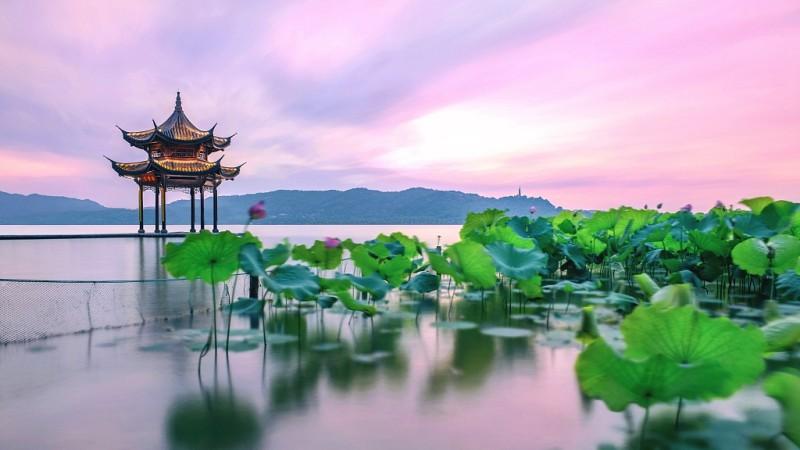
Famous West Lake in Hangzhou - © CGTN
Must-Try Dishes in Hangzhou
Hangzhou’s cuisine is renowned for its fresh ingredients and delicate flavors, reflecting the region’s rich culinary heritage.
- Dongpo Pork: This iconic dish is named after the famous Song Dynasty poet and gourmand Su Dongpo. The pork belly is slow-cooked until tender in a rich, flavorful sauce made with soy sauce, rice wine, and spices. It’s known for its melt-in-your-mouth texture and savory taste.
- West Lake Fish in Vinegar Gravy: This dish features fish caught from West Lake, simmered in a tangy, sweet vinegar sauce. The delicate flavor of the fish pairs perfectly with the sauce, making it a local favorite.
- Longjing Shrimp: Fresh shrimp stir-fried with Longjing tea leaves, this dish combines the subtle fragrance of the tea with the sweetness of the shrimp. It’s a delightful representation of Hangzhou’s famous tea culture.
- Beggar’s Chicken: Traditionally wrapped in lotus leaves and clay before being baked, this dish features chicken stuffed with a mixture of herbs and spices. The result is a succulent and aromatic dish with a unique presentation.
- Stewed Bamboo Shoots with Ham: This dish highlights the local bamboo shoots stewed with cured ham. It's a tasty dish that highlights the region's fresh ingredients and traditional cooking methods.
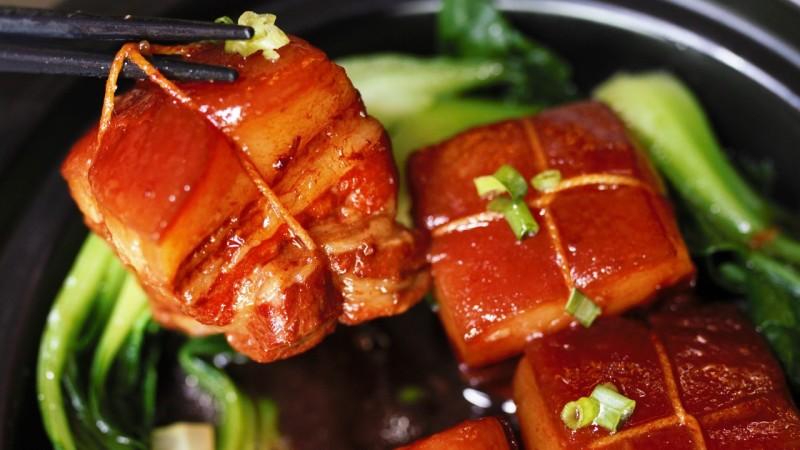
Dongpo Pork - © Curated Kitchenware
Festivals & Local Celebrations
Hangzhou’s vibrant festival scene reflects its rich cultural traditions and seasonal celebrations. Here are some key festivals and local celebrations you should not miss:
- West Lake Cultural Festival: Held annually, this festival celebrates the beauty and cultural significance of West Lake. It features various events such as boat races, traditional performances, and art exhibitions, showcasing the lake’s historical and cultural importance.
- Dragon Boat Festival: This festival honors the memory of the ancient poet Qu Yuan and is conducted on the fifth day of the fifth lunar month. The city hosts dragon boat races on West Lake and offers traditional zongzi (rice dumplings) and other festive foods.
- Hangzhou International Animation Festival: This annual event attracts animation enthusiasts from around the world. It includes screenings, exhibitions, and workshops, highlighting the city’s growing role in the global animation industry.
- Chinese New Year: Like many cities in China, Hangzhou celebrates Chinese New Year with traditional festivities, including lion dances, fireworks, and family gatherings. The city’s vibrant decorations and cultural events create a festive atmosphere.
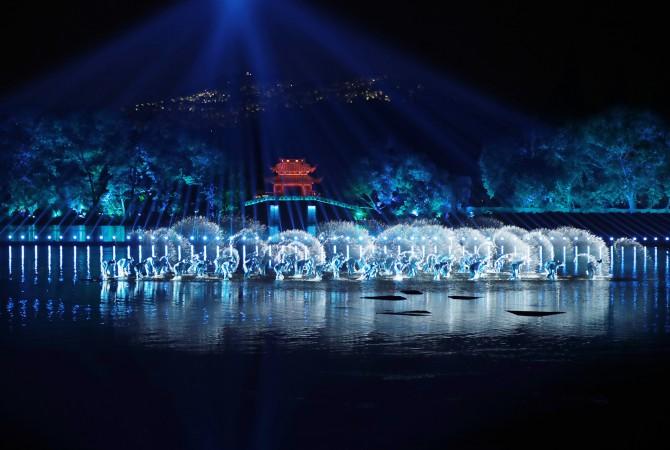
West Lake Cultural Festival - © CGTN
Weather in Hangzhou: Best Time to Visit
Hangzhou experiences a subtropical climate with four distinct seasons, each offering unique beauty and tourism opportunities.
Spring in Hangzhou
- Weather: Spring in Hangzhou is mild and pleasant, with temperatures ranging from 10°C to 22°C (50°F to 72°F). This season is popular among tourists for enjoying the blooming flowers and lush greenery around West Lake.
- Tourism Trend: The West Lake Cultural Festival, held in spring, attracts many visitors with its scenic beauty and cultural events. Cherry blossoms and tea plantations in full bloom offer great photo opportunities and outdoor activities.
Summer in Hangzhou
- Weather: Summers are hot and humid, with temperatures often exceeding 30°C (86°F) and above.
- Tourism Trend: Despite the heat, summer is a bustling time for tourism due to the vibrant atmosphere and numerous festivals. The Dragon Boat Festival, celebrated in June, features lively boat races and traditional activities. Visitors also flock to water parks and scenic spots around West Lake to cool off and enjoy seasonal events.
Autumn in Hangzhou
- Weather: Autumn is considered one of the greatest seasons to visit Hangzhou, with temperatures ranging from 15°C to 25°C (59°F to 77°F).
- Tourism Trend: The fall foliage around West Lake provides stunning views, making it a favorite time for sightseeing and outdoor activities. The Hangzhou International Animation Festival, held in October, draws tourists interested in contemporary culture and entertainment.
Winter in Hangzhou
- Weather: Winters are cool and damp, with temperatures ranging from 0°C to 10°C (32°F to 50°F). However, visitors may feel cooler as a result of the excessive humidity.
- Tourism Trend: Though less crowded, winter offers a serene and quieter experience. This season is ideal for visiting indoor attractions like museums and temples. The Chinese New Year celebrations, held in January or February, bring festive events, traditional performances, and cultural displays, providing a unique experience for visitors during the holiday season.

Winter in Hangzhou - © Eddie Cheng
What to Do in Hangzhou
Hangzhou offers a wealth of activities for tourists to enjoy, from exploring scenic landscapes to experiencing local culture. With these activities, you don't have to worry when thinking of what to do in Hangzhou.
- West Lake Cruises: Enjoy a leisurely boat ride on West Lake to take in its picturesque beauty. You can choose from traditional wooden boats or modern options to explore the lake’s islands and landmarks.
- Tea Plantation Tours: Visit the Longjing tea plantations to learn about tea cultivation and enjoy tastings. The lush green tea fields provide a scenic backdrop for a relaxing day trip.
- Exploring Ancient Temples: Wander through Hangzhou’s historic temples, such as Lingyin Temple and Jingci Temple. These sites provide insight into local spiritual practices and architectural traditions.
- Historic Streets Walking Tours: Explore the ancient streets of Hangzhou, like Qinghefang Ancient Street, to experience traditional architecture, local crafts, and vibrant markets.
- West Lake Cycling Tours: Rent a bike and cycle around West Lake’s scenic paths. It's a great opportunity to appreciate the lake's splendor while also getting some exercise.
Shopping in Hangzhou
Hangzhou provides a diverse shopping experience, from traditional markets to modern malls. Check out these shopping options when you travel to Hangzhou.
- Qinghefang Ancient Street: This bustling street is a shopper’s paradise, offering a range of traditional goods, including silk, handicrafts, and local snacks. Its historic ambiance adds charm to the shopping experience.
- Hangzhou Tower Shopping Mall: Located in the city center, this modern shopping mall features international brands, luxury goods, and dining options. It’s a great place for high-end shopping and entertainment.
- Hangzhou Silk Markets: Hangzhou is renowned for its silk manufacture and silk products. Visit local silk markets to find beautiful silk garments, scarves, and souvenirs. These markets offer both traditional and contemporary designs.
- Local Handicraft Shops: Explore shops selling local handicrafts such as hand-painted fans, calligraphy supplies, and traditional ceramics. These unique items make for memorable souvenirs.
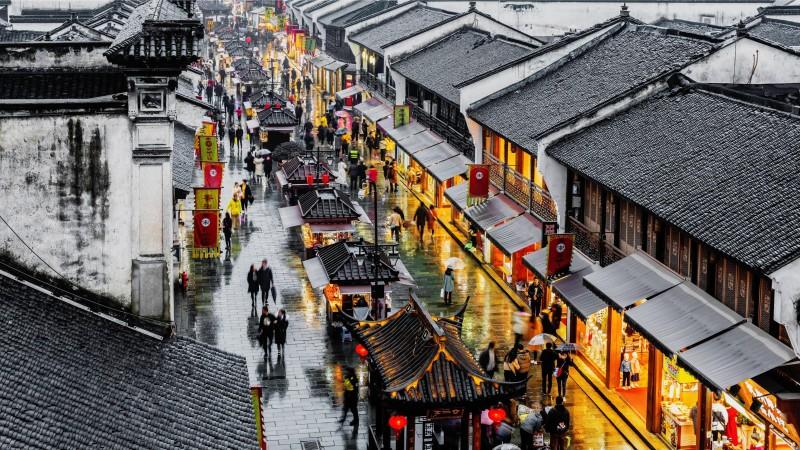
Qinghefang Ancient Street - © China News
Culture Etiquette in Hangzhou
When visiting Hangzhou, understanding and respecting local customs can enhance your experience. Here are some unique cultural etiquettes to keep in mind:
- Greetings: In Hangzhou, a warm smile and a slight nod are common gestures when greeting someone. A handshake is suited for formal contacts, particularly those in business situations. When meeting locals, it is courteous to address them by title and surname, such as "Mr. Zhang" or "Ms. Li".
- Dining Etiquette: When dining, it’s customary to wait for the host to start the meal. Use chopsticks correctly and avoid sticking them upright in a bowl of rice, as it resembles funeral rites. Sharing dishes is common, and it’s polite to offer food to others before serving yourself.
- Respect for Tradition: Hangzhou is rich in cultural and historical sites. When visiting temples or historical landmarks. Show respect at temples and historical sites by dressing modestly and speaking softly. When visiting religious sites, refrain from touching or climbing on artifacts.
- Local Custom - Tea Tasting: Hangzhou is famous for its Longjing tea and the traditional Chinese tea ceremony. When invited to a tea-tasting session, it’s customary to show appreciation for the tea by taking small sips and savoring its flavor. Complimenting the host on their tea-making skills is a gracious gesture.
- Gift-Giving: If you’re invited to someone’s home or attending a local event, bringing a modest gift, such as fruit or specialty items from your home country, is appreciated. Avoid gifts like clocks or umbrellas, as they are associated with funerals and may be seen as inauspicious.
Essential Travel Information
Getting Around Hangzhou
Hangzhou offers a range of transportation options to suit every need. Navigating Hangzhou has never been easier with these transportation methods.
- Public Transport: The city’s efficient public transportation system includes buses and a modern metro network. The Hangzhou Metro provides convenient access to major attractions and is easy to navigate.
- Taxis: Taxis are readily available throughout the city. They are a convenient option for getting around, especially if you’re traveling with luggage or in a group. Make sure your destination is printed in Chinese, as not all drivers know English.
- Bicycles: Hangzhou is bike-friendly, with numerous bike-sharing programs and dedicated bike lanes. Renting a bicycle is a terrific way to see the city at your own leisure, especially around West Lake.
- Car Rentals: If you prefer driving, car rentals are available. However, be mindful of traffic conditions and parking regulations. Renting a car is ideal for day trips to nearby attractions.
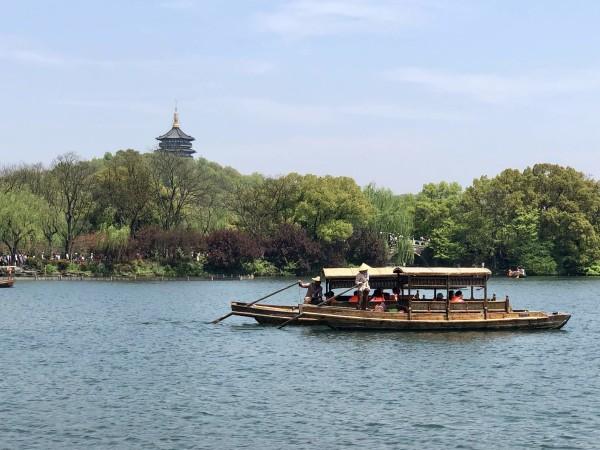
West Lake Cruise - © Wikipedia
ATM & Banking Services
Accessing banking services in Hangzhou is straightforward. ATMs are widely available throughout the city, especially in shopping areas and near major tourist attractions, and most accept international cards. It’s a good idea to notify your bank before traveling to ensure smooth transactions. For a range of services including currency exchange and account management, you can visit various banks scattered across key locations. Currency exchange services are also readily available at hotels and dedicated exchange offices. Carrying some local currency is advisable for small purchases and tips.
Where to Stay in Hangzhou
Hangzhou offers a diverse range of accommodation options to suit various preferences and budgets. For a luxurious experience, you can choose high-end hotels that provide exceptional amenities, stunning views, and top-notch service. Comfortable mid-range hotels offer a good balance of comfort and affordability. Budget travelers will find hostels and budget hotels with affordable rates and basic amenities. Additionally, boutique hotels and guesthouses offer a more personalized stay, featuring unique decor and local charm, making them an excellent choice for those seeking a distinctive experience.
Articles for you

Explore Yala National Park - Sri Lanka Travel, Asia
Tucked away in Sri Lanka’s southeastern corner, Yala National Park is where wild nature meets deep tradition. Known worldwide for its leopard population, the park is also home to elephants, sloth bears, crocodiles, and hundreds of bird species. Beyond wildlife, Yala opens doors to a cultural landscape dotted with ancient temples, Buddhist ruins, and coastal villages. For travelers seeking more than just a safari, Yala offers a chance to explore eco-tourism, local communities, and sacred heritage sites.
Population: The Yala National Park area doesn’t have a human population.
Economy: The economy around Yala National Park thrives on a blend of eco-tourism, agriculture, and local services. Safari tours, eco-lodges, and cultural experiences drive steady income for nearby towns like Tissamaharama and Kataragama, supporting thousands of families.
Landmarks: Famous for Block I of Yala and wildlife encounters, including elephants, sloth bears, crocodiles, and exotic bird species.

Explore Galle - Sri Lanka Travel, Asia
Nestled on Sri Lanka’s southern coastline, Galle is a vibrant city where history meets the sea. Its cobbled streets, colonial architecture, and serene beaches make it a must-visit destination for travelers seeking a blend of culture, adventure, and relaxation. A UNESCO World Heritage site, Galle captivates visitors with its Dutch Fort, bustling markets, and friendly locals. Whether you’re exploring the ramparts at sunset or savoring fresh seafood by the shore, Galle promises an unforgettable journey into Sri Lanka’s heritage.
Population: Approximately 113,000 in 2023.
Economy: Galle’s economy thrives on tourism, trade, and fisheries. The city’s historic fort, colonial architecture, and coastal charm draw thousands of international visitors each year, making tourism its main economic driver. Fishing remains vital for local livelihoods, supplying fresh seafood across the region.
Landmarks: Famous for the Galle Fort, Dutch Reformed Church & Maritime Museum, and Unawatuna Beach.

Explore Bentota - Sri Lanka Travel, Asia
Nestled along Sri Lanka’s southwestern coast, Bentota is a tropical paradise that blends golden beaches, vibrant culture, and thrilling adventures. Famous for its calm waters, luxury resorts, and scenic river estuary, Bentota has become a top destination for travelers seeking both relaxation and authentic experiences. From serene beach walks at sunrise to adrenaline-pumping water sports, this coastal town offers a perfect balance of leisure and exploration. With its proximity to Colombo and Galle, Bentota is easy to reach, making it an ideal stop for both short escapes and extended holidays.
Population: Approximately 37,000 in 2023.
Economy: Bentota’s economy thrives mainly on tourism, which drives local businesses such as hotels, restaurants, and wellness retreats. The town also benefits from fishing, coconut cultivation, and handicrafts like wood carving and batik textiles. Many residents rely on the growing demand for water sports and Ayurvedic treatments, making tourism the backbone of both income and employment in the area.
Landmarks: Famous for Bentota Beach, Bentota River Safari, and Kande Vihara Temple.

Explore Mirissa - Sri Lanka Travel, Asia
Mirissa is a charming coastal town on Sri Lanka’s southern shoreline. Known for its golden beaches, turquoise waters, and vibrant marine life, it has become a must-visit stop for travelers exploring the island. Many come for whale watching, surfing, and sunset views at Coconut Tree Hill, but Mirissa offers much more than postcard beauty. The fishing boats you see anchored by the bay carry generations of stories. Local traditions, delicious cuisine, and a laid-back rhythm of life shape every visitor’s experience.
Population: Approximately 4,700 in 2023.
Economy: Mirissa’s economy is largely shaped by its coastal location. Fishing has long been the backbone of local livelihoods, with generations relying on the Indian Ocean for income. In recent decades, tourism has become the main driver of growth, thanks to whale watching, surfing, and beachside hospitality.
Landmarks: Famous for Mirissa Beach, Coconut Tree Hill, and Parrot Rock Bridge.

Explore Nuwara Eliya - Sri Lanka Travel, Asia
Tucked away in the Central Highlands of Sri Lanka, Nuwara Eliya is often called “Little England”. With its rolling tea plantations, cool misty mornings, and colonial charm, this mountain town feels like a step into another world. Travelers come here to breathe fresh air, walk through flower gardens, sip the finest Ceylon Tea, and enjoy a pace of life far from the island’s busy cities. Whether you’re drawn by scenic landscapes, heritage architecture, or the warmth of its people, Nuwara Eliya is a destination that blends nature, culture, and history in perfect harmony.
Population: Approximately 781,000 in 2023.
Economy: Nuwara Eliya’s economy thrives mainly on tea production, as it sits in the heart of Sri Lanka’s central highlands, famous worldwide for Ceylon Tea. The city also benefits from a growing tourism industry, attracting visitors with its colonial charm, cool climate, and scenic landscapes.
Landmarks: Famous for Gregory Lake, Hakgala Botanical Garden, and Victoria Park.

Explore Sukau - Malaysia Travel, Asia
Nestled on the banks of the Kinabatangan River in Sabah, Malaysian Borneo, Sukau is a destination where wildlife, culture, and conservation come together. Known as one of Asia’s top spots for river safaris and eco-tourism, this quiet village offers a front-row seat to encounters with Bornean orangutans, pygmy elephants, proboscis monkeys, and exotic birdlife.
Population: Approximately 1,400 in 2019.
Economy: Sukau’s economy is shaped by its riverine location and natural resources. Traditionally, the Orang Sungai community relied on fishing, small-scale farming, and forest gathering for their livelihood. Today, the village has shifted toward eco-tourism, with river cruises, jungle trekking, and homestays providing income.
Landmarks: Famous for the Kinabatangan River cruises, Gomantong Caves, and Ox-bow lakes and wetlands.
